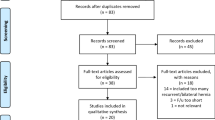Abstract
Background: Laparoscopic hernia repair excites controversy because its benefits are debatable and critics claim it is attended by serious complications. The one group of patients in whom benefits may outweigh the perceived disadvantages are those with bilateral or recurrent inguinal hernias. Method: One hundred twenty patients with bilateral or recurrent hernias were randomized to either laparoscopic transabdominal preperitoneal (TAPP) or open mesh repair. Patients completed a well-being questionnaire prior to and following surgery together with a visual analog pain score. Patients were followed up clinically at 1 and 3 months and thereafter by their general practitioner. Results: Age and sex distribution was similar in the two groups. Laparoscopic TAPP hernia was quicker (40 vs 55 min; p < 0.001), less painful (visual analog pain score, 2.8 vs 4.3; p = 0.003) and allowed earlier return to work (11 vs 42 days; p < 0.001) compared to open mesh repair. Conclusion: This trial demonstrates that laparoscopic hernia repair via the TAPP route offers significant benefit to patients undergoing bilateral or recurrent inguinal hernia repair.
Similar content being viewed by others
References
GL Beets CD Dirkson PM Go FE Geisler CG Baeten G Kootstra (1999) ArticleTitleOpen or laparoscopic preperitoneal mesh repair for recurrent inguinal hernia? A randomised controlled trail. Surg Endosc 13 323–327 Occurrence Handle1:STN:280:DyaK1M7psVyluw%3D%3D Occurrence Handle10094739
GL Beets KJ Oosterhuis PMNYH Go CGMI Baeten G Koostra (1997) ArticleTitleLong-term follow-up (12–15 years) of a randomised controlled trial comparing Bassini–Stetten, Shouldice, and a high legation with narrowing of the internal ring for primary inguinal hernia repair. J Am Coll Surg 185 352–357 Occurrence Handle10.1016/S1072-7515(97)00065-3 Occurrence Handle1:STN:280:ByiH28jgsVc%3D Occurrence Handle9328383
T Callesen K Bech H Kehlet (1999) ArticleTitleProspective study of chronic pain after groin hernia repair. Br J Surg 86 1528–1531 Occurrence Handle10.1046/j.1365-2168.1999.01320.x Occurrence Handle10594500
J Cunningham WJ Temple P Mictchell J Nixon RM Preshaw NA Hagen (1996) ArticleTitleCooperative hernia study: pain in the postrepair patient. Ann Surg 224 598–602 Occurrence Handle10.1097/00000658-199611000-00003 Occurrence Handle8916874
B Decadt L Sussman MP Lewis A Seeker L Cohen C Rogers A Patel M Rhodes (1999) ArticleTitleRandomized clinical trial of early laparoscopy in the management of acute non-specific abdominal pain. Br J Surg 86 1383–1386 Occurrence Handle10.1046/j.1365-2168.1999.01239.x Occurrence Handle1:STN:280:DC%2BD3c%2FltFWkuw%3D%3D Occurrence Handle10583282
E Dimenas (1993) ArticleTitleMethodological aspects of evaluation of quality of life in upper gastrointestinal ease. Scand J Gastroeneterol Suppl 199 18–21 Occurrence Handle1:STN:280:ByuB38rhslw%3D
HJ Dupy (1984) The psychological general well-being (PGWB) index. NK Wenger ME Mattson . Furberg (Eds) Assessment of quality of life in clinical trials of cardiovascular therapies le Jacq Publishing USA 170–183
InstitutionalAuthorNameEU Hernia Trialists Collaboration (2000) ArticleTitleMesh compared with non-mesh methods of open groin hernia repair: systematic review of randomised controlled trials. Br J Surg 87 854–859 Occurrence Handle10931018
CE Frankum BJ Ramshaw J White TD Duncan RA Wilson EM Mason G Lucas J Promes (1999) ArticleTitleLaparoscopic repair of bilateral and recurrent inguinal hernias. Am Surgeon 65 839–842 Occurrence Handle1:STN:280:DyaK1MvhtFyrtQ%3D%3D Occurrence Handle10484086
P Juul K Christensen (1999) ArticleTitleRandomized clinical trial of laparoscopic versus open inguinal hernia repair. Br J Surg 86 316–319 Occurrence Handle10.1046/j.1365-2168.1999.01053.x Occurrence Handle10201770
R Kozol PM Lange M Kosir K Beleski K Mason S Tennenberg S Kubinec R Wilson (1997) ArticleTitleA prospective, randomised study of open vs laparoscopic inguinal hernia repair. Arch Surg 132 292–295 Occurrence Handle9125030
IL Lichtenstein AG Shulman PK Amid MM Monttlor (1989) ArticleTitleThe tension free hernioplasty. Am J Surg 157 188–193 Occurrence Handle1:STN:280:BiaC3s3ptlA%3D Occurrence Handle2916733
MA Memon X Feliu EF Sallent J Camps RJ Fitzgibbons Jr (1999) ArticleTitleLaparoscopic repair of recurrent hernias. Surg Endosc 13 807–810 Occurrence Handle10430691
InstitutionalAuthorNameMRC Laparoscopic Groin Hernia Trial Group (1999) ArticleTitleLaparoscopic versus open repair of groin hernia: a randomised comparison. Lancet 354 185–190 Occurrence Handle10421299
InstitutionalAuthorNameNational Institute for Clinical Excellence (2001) Guidance on the use of laparoscopic surgery for inguinal hernia. National Institute for Clinical Excellence London
InstitutionalAuthorNameOffice of Population Censuses and Surverys (1995) Hospital episode statistics 1993–4. HMSO London
AS Poobalan J Bruce PM King WA Chambers ZH Krukowski WCS Smith (2001) ArticleTitleChronic pain and quality of life following open inguinal hernia repair. Br J Surg 88 1122–1126 Occurrence Handle1:STN:280:DC%2BD3MvktlWgtg%3D%3D Occurrence Handle11488800
D Ravichandran BG Kalambe JA Pain (2000) ArticleTitlePilot randomised controlled study of preservation or division of ilioinguinal nerve in open mesh repair of inguinal hernia. Br J Surg 87 1166–1167 Occurrence Handle1:STN:280:DC%2BD3M%2Fjs1Oksw%3D%3D Occurrence Handle10971422
J Svedlund I Sjodin G Dotevall (1988) ArticleTitleGSRS—a clinical rating scale for gastrointestinal symptoms patients with irritable bowl syndrome and peptic ulcer disease. Dig Dis Sci 33 129–134 Occurrence Handle1:STN:280:BieC3M%2Fpt1A%3D Occurrence Handle3123181
Acknowledgements
We are grateful for the help of the following surgeons, who allowed us to see and operate on their patients: T. Cheatle, J. Clarke, J. Colin, C. Speakman, W. Stebbings, and D. Ralphs. David Mahon and Bart Decadt worked as fellows in laparoscopic surgery during this study and were partially funded by Ethicon Endosurgery (UK).
Author information
Authors and Affiliations
Corresponding author
Rights and permissions
About this article
Cite this article
Mahon, D., Decadt, B. & Rhodes, M. Prospective randomized trial of laparoscopic (transabdominal preperitoneal) vs open (mesh) repair for bilateral and recurrent inguinal hernia . Surg Endosc 17, 1386–1390 (2003). https://doi.org/10.1007/s00464-002-9223-x
Received:
Accepted:
Published:
Issue Date:
DOI: https://doi.org/10.1007/s00464-002-9223-x




